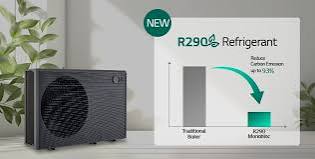Introduction
While climate change remains a center-stage issue globally, there has been a call for more sustainable, efficient, and environmentally friendly heating and cooling systems. Among all the technologies available and competing for a place in the spotlight, the R290 heat pump can be considered the most promising. A popular heating device that is energy-efficient, environmentally friendly, and suitable for a wide range of applications is the R290 heat pump. This article examines the various aspects of the R290 heat pumps including their characteristics, advantages, and disadvantages, emphasizing their application in future sustainable heating and cooling.
Understanding R290: What is it?
R290 also known as propane is a group of hydrocarbons used in heat pump systems. Unlike traditional refrigerants like R410A and R134a which have high GWP values, R290 is a green refrigerant that has a GWP of only 3. This makes it ideal in the quest for environment-friendly refrigerants especially in compliance with the Kigali Amendment to the Montreal Protocol.
How R290 Heat Pumps Function
In general, heat pumps work by moving heat around from one place to another, by using the processes involved in a refrigeration cycle.
1. Evaporation: The R290 refrigerant, through vaporization, extracts heat from the surrounding air, ground or water.
2. Compression: The vaporized refrigerant is then compressed and the process increases its temperature and pressure.
3. Condensation: The hot, pressurized refrigerant then transfers the heat to the targeted area (inside the environment or water for warming) and turns it back into a liquid.
4. Expansion: It vaporizes, and the pressure and temperature drop so that it is ready to take in heat once more.
This cycle is very efficient and can supply heating and cooling therefore making R290 heat pumps ideal for all-year usage.
Advantages of R290 Heat Pumps
1. Environmental Benefits:
Low GWP: As stated earlier, R290 has a GWP of 3, which is considerably lower than that of other standard refrigerants, which have GWPs in the thousands.
Zero Ozone Depletion Potential (ODP): R290 does not cause depletion of the ozone layer, as regarded by international environmental laws.
2. Energy Efficiency:
High Coefficient of Performance (COP): It is also worth reminding that heat pumps using R290 refrigerant are more effective than heat pumps using other types of refrigerants in terms of COP. This makes them able to generate more heat or cool for the same amount of energy consumed, resulting in low energy consumption and therefore less generation of greenhouse gases.
Versatility in Applications: These heat pumps can be installed in homes, business places, and industries because of their efficiency and the fact that they can operate at any temperature range.
3. Operational Benefits:
Reliability: R290 systems are highly reliable and can last for a longer time depending on their usage and regular servicing and maintenance.
Cost-Effectiveness: This way, the energy consumption and thus the CO₂ emissions of R290 heat pumps are then lower and consequently, it can also be cheaper in the long run even if the costs for purchasing can be higher.
Application of R290 Heat Pump
1. Residential Heating and Cooling:
Space Heating: R290 heat pumps can be used to heat homes as they are effective and provide a constant stream of heat.
Cooling Solutions: They also have the advantage of being able to cool hence good for use all year, especially in the hot areas or season.
2. Commercial and Industrial Uses:
Large-Scale Heating: R290 heat pumps emit low amounts of greenhouse gases and are energy efficient; therefore, they should be adopted for use in commercial buildings like offices, shopping complexes, and industries, for instance, manufacturing firms.
Process heating and Cooling: R290 can also be used in industries that have specific temperature requirements in their production processes such as in the food processing and drug manufacturing industries.
3. Hot Water Production:
Domestic Hot Water: It can also be used to generate hot water to be used in household requirements through the use of R290 heat pumps.
Commercial Hot Water Systems: These heat pumps can be adopted in hotels, hospitals, and other large organizations due to high hot water consumption.
Challenges and Considerations
1. Flammability:
Safety Concerns: R290 is combustible, thus posing a safety issue especially when handling, installing, and maintaining the refrigerator. It is thus very important to conform to certain measures and guidelines to reduce such risks.
Regulatory Restrictions: Some of the regions have stringent laws concerning the usage of inflammable refrigerants, which may hamper the installation of R290 heat pumps.
2. Market Availability and Cost:
Initial Investment: They may cost more upfront when compared to traditional systems, especially the R290 heat pump systems. Nevertheless, this is usually compensated by lesser operating expenses as well as power conservatory in the future.
Market Penetration: The R290 heat pump market is still emerging, however, it has been expanding steadily. Market demands and technological advancements in production may mean lower prices and better accessibility.
3. Technical Expertise:
Training and Knowledge: Flammable and toxic, R290 also requires technical training for both technicians and installers to work with it safely and efficiently. To ensure greater penetration of this technology, more resources should be directed toward the training of the workforce.
Future Prospects
Future trends show that R290 heat pumps will be more popular in the future due to the development of new technologies and consumer demands for the reduction of greenhouse gas emissions. Current research and development is concerned with the optimization of R290 systems in terms of safety and efficiency. Timely developments like better leak detection techniques, better system design, and enhanced safety measures are aiding in managing risks related to flammable refrigerants.
Furthermore, as demand in the global sustainable heating and cooling market increases, the production volume is believed to reduce the cost of R290 heat pumps. Promotion and subsidization of green technologies also foster the uptake of R290 heat pumps, specifically as it relates to emissions reductions and the fight against climate change.
Conclusion
R290 heat pumps can be considered an important advancement in the search for effective and eco-friendly heating and cooling systems. This is because of their environmental impacts, effectiveness in using energy, and their suitability to be used in different applications. Some of the issues like flammability and high first costs are there but these are improving with continuous progress and increased use in the market.





